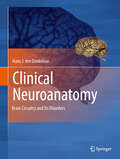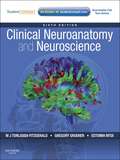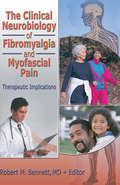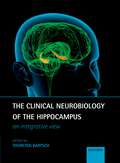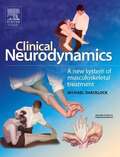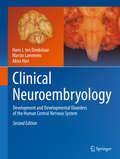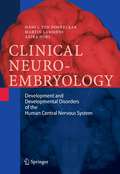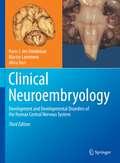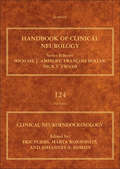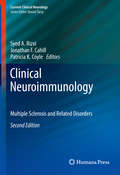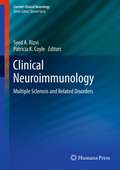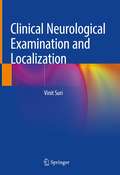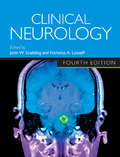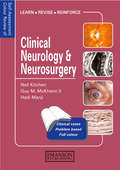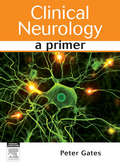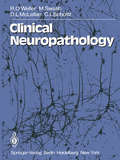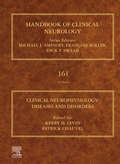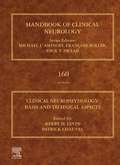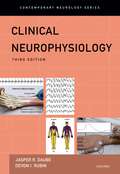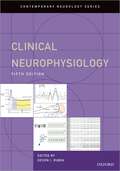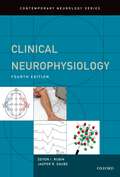- Table View
- List View
Clinical Neuroanatomy: Brain Circuitry and Its Disorders
by Hans J. ten DonkelaarConnections define the functions of neurons: information flows along connections, as well as growth factors and viruses, and even neuronal death may progress through connections. Knowledge of how the various parts of the brain are interconnected to form functional systems is a prerequisite for the proper understanding of data from all fields in the neurosciences.Clinical Neuroanatomy: Brain Circuitry and Its Disorders bridges the gap between neuroanatomy and clinical neurology. It emphasizes human and primate data in the context of disorders of brain circuitry which are so common in neurological practice. In addition, numerous clinical cases demonstrate how normal brain circuitry may be interrupted and to what effect. Following an introduction into the organization and vascularisation of the human brain and the techniques to study brain circuitry, the main neurofunctional systems are discussed, including the somatosensory, auditory, visual, motor, autonomic and limbic systems, the cerebral cortex and complex cerebral functions.
Clinical Neuroanatomy and Neuroscience E-Book
by Estomih Mtui Gregory Gruener M. J. FitzGeraldClinical Neuroanatomy and Neuroscience by Drs. M. J. T. FitzGerald, Gregory Gruener, and Estomih Mtui, already known as the most richly illustrated book available to help you through the complexity of neuroscience, brings you improved online resources with this updated edition. You’ll find the additional content on Student Consult includes one detailed tutorial for each chapter, 200 USMLE Step I questions, and MRI 3-plane sequences. With clear visual images and concise discussions accompanying the text’s 30 case studies, this reference does an impressive job of integrating clinical neuroanatomy with the clinical application of neuroscience.Aid your comprehension of this challenging subject by viewing more than 400 explanatory illustrations drawn by the same meticulous artists who illustrated Gray’s Anatomy for Students. Get a complete picture of different disorders such as Alzheimer’s disease and brain tumors by reading about the structure, function, and malfunction of each component of the nervous system. Grasp new concepts effortlessly with this book’s superb organization that arranges chapters by anatomical area and uses Opening Summaries, Study Guidelines, Core Information Boxes, Clinical Panels, and 23 "flow diagrams," to simplify the integration of information. Use this unique learning tool to help you through your classes and prep for your exams, and know that these kind of encompassing tutorials are not usually available for self-study. Access outstanding online tutorials on Student Consult that deliver a slide show on relevant topics such as Nuclear Magnetic Resonance and Arterial Supply of the Forebrain. Confidently absorb all the material you need to know as, for the first time ever, this edition was reviewed by a panel of international Student Advisors whose comments were added where relevant. Understand the clinical consequences of physical or inflammatory damage to nervous tissues by reviewing 30 case studies.
The Clinical Neurobiology of Fibromyalgia and Myofascial Pain: Therapeutic Implications
by Robert M. BennettIs chronic fatigue syndrome an early process of muscle aging? Is fibromyalgia a central pain state? This book covers the latest developments in pain research as presented at the Fifth World Congress on Myofascial Pain (MYOPAIN 2001). It examines the results of a wide scope of basic and applied research on soft-tissue pain, with a strong focus on therapeutic approaches. Its three main sections explore the neurobiology of central sensitization, regional pain syndromes, and chronic widespread pain. In addition, this well-referenced book presents a fascinating chapter on the complex relationship between muscle pain and aging. Handy graphs, charts, and illustrations make the information easy to assimilate. The Clinical Neurobiology of Fibromyalgia and Myofascial Pain: Therapeutic Implications contains up-to-date information on: the brain?s reactions to states of persistent pain the physical aftermath of torture ways to define and address the emotional distress that commonly observed in chronic pain patients the mechanisms and manifestations of muscle hyperalgesia the pathophysiology of inflammatory muscle pain regional muscle pain syndromes state-of-the-art information on the pathophysiology of visceral pain and visceral-somatic pain representations a case study of a physical therapy approach to fibromyalgia using Myofascial trigger points the epidemiology of widespread pain and its development after injuries syndromes that share overlapping clinical features with fibromyalgia the connection between HPA dysfunction, ANS dysfunction, and fibromyalgia the plasticity of excitatory synaptic transmission in the spinal dorsal horn and its role in the pathogenesis of pain hypersensitivity how the central mechanisms of pain transmission relate to pharmacological systems that are responsible for generating central sensitization states what PET and MRI show us about the role that the cerebral cortex plays in the perception and modulation of pain
The Clinical Neurobiology of Fibromyalgia and Myofascial Pain: Therapeutic Implications
by Robert M. BennettIs chronic fatigue syndrome an early process of muscle aging? Is fibromyalgia a central pain state? This book covers the latest developments in pain research as presented at the Fifth World Congress on Myofascial Pain (MYOPAIN 2001). It examines the results of a wide scope of basic and applied research on soft-tissue pain, with a strong focus on therapeutic approaches. Its three main sections explore the neurobiology of central sensitization, regional pain syndromes, and chronic widespread pain. In addition, this well-referenced book presents a fascinating chapter on the complex relationship between muscle pain and aging. Handy graphs, charts, and illustrations make the information easy to assimilate. The Clinical Neurobiology of Fibromyalgia and Myofascial Pain: Therapeutic Implications contains up-to-date information on: the brain?s reactions to states of persistent pain the physical aftermath of torture ways to define and address the emotional distress that commonly observed in chronic pain patients the mechanisms and manifestations of muscle hyperalgesia the pathophysiology of inflammatory muscle pain regional muscle pain syndromes state-of-the-art information on the pathophysiology of visceral pain and visceral-somatic pain representations a case study of a physical therapy approach to fibromyalgia using Myofascial trigger points the epidemiology of widespread pain and its development after injuries syndromes that share overlapping clinical features with fibromyalgia the connection between HPA dysfunction, ANS dysfunction, and fibromyalgia the plasticity of excitatory synaptic transmission in the spinal dorsal horn and its role in the pathogenesis of pain hypersensitivity how the central mechanisms of pain transmission relate to pharmacological systems that are responsible for generating central sensitization states what PET and MRI show us about the role that the cerebral cortex plays in the perception and modulation of pain
The Clinical Neurobiology of the Hippocampus: An integrative view
The hippocampus is one of the most studied structures in the human brain and plays a pivotal role in human memory function. Its recognized function is reflected by the presence of an extensive body of neurophysiological, neuropsychological, anatomical and neurocomputational literature that presents basic mechanisms, theoretical models and psychological concepts. However, in the rapidly growing field of hippocampal research, the clinical aspects of diseases that affect the hippocampus are greatly under-represented in current literature, and clinical approaches and concepts are scattered throughout various clinical and basic scientific disciplines. The Clinical Neurobiology of the Hippocampus explores clinical approaches to the range of diseases that affect the hippocampus. It brings together and reviews the common methods, clinical findings, concepts, mechanisms and, where applicable, therapeutic strategies for these clinical approaches. The clinical spectrum of hippocampal dysfunction encompasses a wide range of neurological, behavioural and psychiatric symptoms and surpasses the ability to encode, store and retrieve information. The relevance of hippocampal involvement in clinical diseases goes beyond mere neuropsychological deficits and includes psychopathological states in various conditions, such as acute amnesic syndromes, Alzheimer's disease, temporal lobe epilepsy (TLE), sleep, stroke medicine, limbic encephalitis, neurodevelopmental disorders, stress- and trauma-related disorders, depression, and schizophrenia. The first part of the book covers the basic and integrative features of the hippocampus, such as the anatomy and imaging of this structure, and the basic mechanisms of hippocampal function, including the principles of hippocampus-dependent memory processing in amnesia and sleep, the mechanisms of vulnerability and adult neurogenesis as well as the effects of stress. The second part covers the various clinical manifestations in which the hippocampus is involved and in which the preceding basic mechanisms are reflected. Bringing together a broad team of experts on the basic and clinical aspects of the hippocampus, the book provides an integrative view of the hippocampus. It is invaluable for neurologists, neuroscientists, and psychiatrists, and will stimulate interdisciplinary discussions in clinical neuroscience.
Clinical Neurodynamics: A New System Of Neuromusculoskeletal Treatment (19) (PDF)
by Michael ShacklockA groundbreaking approach to neural mobilization, this one-of-a-kind resource draws on the established Maitland movement diagram to present a completely new system for mobilization of the neural and musculoskeletal systems. The text guides readers through the complex subject of neurodynamics and the basic mechanisms in movement of the nervous system, systematically linking causal mechanisms to diagnosis and treatment of pain and common musculoskeletal problems. This new progressional method is ideal for diagnosis and treatment of musculoskeletal disorders with neural involvement such as spinal and peripheral (extremity) disorders, the nerve root, dura and peripheral nerve.
Clinical Neuroembryology: Development and Developmental Disorders of the Human Central Nervous System
by Hans J. ten Donkelaar Martin Lammens Akira HoriThis book provides a comprehensive overview of the development of the human central nervous system (CNS) in the context of its many developmental disorders due to genetic, environmental, and hypoxic/ischemic causes. The introductory chapters give an overview of the development of the human brain and the spinal cord, the mechanisms of development as obtained in experimental studies of various invertebrates and vertebrates, and the causes of congenital malformations. In the main part, the developmental disorders of the human brain and the spinal cord are presented in a regional, more or less segmental way, starting with neurulation and neural tube defects, and ending with developmental disorders of the cerebral cortex. These are underlined by carefully chosen clinical case studies, including imaging data and, when available, postmortem verification of the developmental disorders involved. Numerous color photographs and illustrations complement the text.This second edition emphasizes the prenatal diagnosis by ultrasound, MRI, and DTI and implements new classifications of developmental disorders.
Clinical Neuroembryology: Development and Developmental Disorders of the Human Central Nervous System
by Hans J. ten Donkelaar Martin Lammens Akira HoriProgress in developmental neurobiology and advances in (neuro) genetics have been spectacular. The high resolution of modern imaging techniques applicable to developmental disorders of the human brain and spinal cord have created a novel insight into the developmental history of the central nervous system (CNS). This book provides a comprehensive overview of the development of the human CNS in the context of its many developmental disorders. It provides a unique combination of data from human embryology, animal research and developmental neuropathology, and there are more than 400 figures in over a hundred separate illustrations.
Clinical Neuroembryology: Development and Developmental Disorders of the Human Central Nervous System
by Hans J. ten Donkelaar Martin Lammens Akira HoriThis book provides a comprehensive overview of the development of the human central nervous system (CNS) in the context of its many developmental disorders due to genetic, environmental and hypoxic/ischaemic causes. The book contains three general, introductory chapters in which an overview of the development of the human brain and spinal cord, a summary of mechanisms of development as obtained in experimental studies in various invertebrates and vertebrates, and an overview of the causes of congenital malformations are presented. The developmental disorders of the human brain and spinal cord are presented in a regional, more or less segmental way, starting with neurulation and neural tube defects, and ending with developmental disorders of the cerebral cortex. These chapters are abundantly illustrated in colour with carefully chosen clinical case studies with imaging data, and when available, postmortem verification of the developmental disorders involved.In the third edition, more emphasis has been given to the developmental ontology based on the prosomeric approach, and fetal development. Prenatal diagnosis by ultrasound, MRI and DTI, and classifications of developmental disorders have been updated. A number of new Clinical Cases have been included. Several new co-authors participate in various chapters. The book is intended for advanced medical students, and all those clinicians working with children and adults with developmental disorders of the CNS. Unique to the book is the integration of data from human embryology, experimental and molecular findings in mice in particular, imaging and developmental neuropathology.
Clinical Neuroendocrinology (ISSN #Volume 124)
by Eric Fliers Marta Korbonits J. A. RomijnClinical Neuroendocrinology, a volume in the Handbook of Clinical Neurology Series gives an overview of the current knowledge in the field of clinical neuroendocrinology. It focuses on the pathophysiology, diagnosis, and treatment of diseases of the hypothalamus and the pituitary gland. It integrates a large number of medical disciplines, including clinical endocrinology, pediatrics, neurosurgery, neuroradiology, clinical genetics, and radiotherapy. Psychological consequences of various disorders and therapies, as well as therapeutic controversies, are discussed. It is the first textbook in the field to address all these aspects by a range of international experts. All contributors are recognized experts in the different fields of clinical neuroendocrinology The book provides expanded coverage on hypothalamic mechanisms in human pathophysiology The book includes current perspectives, diagnosis and treatment of pituitary diseases
Clinical Neuroimmunology: Multiple Sclerosis and Related Disorders (Current Clinical Neurology)
by Syed A. Rizvi Jonathan F. Cahill Patricia K. CoyleThis comprehensive, up-to-date book is designed to make recent developments in neuroimmunology accessible to medical professionals in the field. The field of neuroimmunology is complex and rapidly evolving, especially with the current improvements in targeted biologic therapies. This resource concisely offers clear explanations of these scientific and clinical advancements. Divided into five parts, the book begins with an in-depth introduction to neuroimmunology and the principles of immunotherapy. Section two consists of eight chapters devoted to multiple sclerosis, including discussions on the clinical features of the disease as well as symptom management and diagnosis. Subsequent chapters then dive into other central nervous system inflammatory disorders such as neuromyelitis optica, autoimmune encephalopathies, and immunological aspects of cancer. Following this are two chapters that examine distinct aspects of autoimmune disorders of the peripheral nervous system. Finally, the book closes with a review on the neurologic manifestations, diagnostic approaches and treatments of the various systemic rheumatic diseases. Following its successful predecessor edition, Clinical Neuroimmunology: Multiple Sclerosis and Related Disorders, Second Edition is positioned to be an invaluable asset to neurologists, residents and fellows, internists, and general practitioners who treat patients with neurologic disorders and other systemic autoimmune diseases.
Clinical Neuroimmunology: Multiple Sclerosis and Related Disorders (Current Clinical Neurology)
by Syed A. A. Rizvi and Patricia K. K. CoyleClinical Neuroimmunology: Multiple Sclerosis and Related Disorders serves as an indispensable resource for physicians interested in, and dealing with, this very complex and evolving branch of neurology. This comprehensive title provides an introduction to basic neuroimmunology and principles of immunotherapy and also serves as a thorough guide to immune-mediated disorders of the central and peripheral nervous system, as well as other systemic disorders with a significant neuroimmunologic component. The chapters are written by experts in their fields and include the most up to date scientific information. This volume is made to simplify complex immunological mechanisms and to focus on practical patient-related issues. Clinical Neuroimmunology: Multiple Sclerosis and Related Disorders is an invaluable addition to the literature and will be of significant interest to neurologists, residents and fellows, internists, and general practitioners who treat patients with neurologic disorders and other systemic autoimmune diseases.
Clinical Neurological Examination and Localization
by Vinit SuriBedside Neurological examination is an important tool in diagnosing neurological disorders . Despite significant advances in the investigations available for diagnosing neurological disorders bedside neurological examination remains the cornerstone in diagnosing neurological disorders and should not only be conducted prior to the investigations but should be actually be utilized to plan the appropriate investigations .The book provides a focused account of various aspects of the neurological examination leading to clinical localisation and hence obtaining the neurological diagnosis. It includes topics like' how to obtain a appropriate neurological history' , 'higher mental system examination', examination of speech and various cranial nerves and examination of other systems including motor system, sensory system, reflexes , cerebellar and autonomic nervous system.The book also includes certain interesting topics like 'neurological examination of the unconscious patient 'and 'tricks and tips of neurological localisation. The book is easy to read and memorize due to multiple self explanatory illustrations and important aspects being highlighted in bulleted format. The book will be of extreme help for MD and DNB students of Internal Medicine as well as DM and DNB students of Neurology and DNB and MCH Neurosurgery students , hence covering a fairly large readership base . It will also be read by practising Internal medicine physicians , neurologists and neurosurgeons who may want to revise the basics and tricks of neurological examination and localization
Clinical Neurology
by T.J. Fowler John W. Scadding Nick Losseff J.W. ScaddingConcise yet comprehensive, Clinical Neurology, Fourth Edition builds on the success of three previous editions in helping medical students, junior doctors, and practicing physicians acquire an improved understanding of the principles of neurology.The fourth edition has been fully revised and updated to take into account current developments in the
Clinical Neurology
by T.J. Fowler John W. Scadding Nick Losseff J.W. ScaddingConcise yet comprehensive, Clinical Neurology, Fourth Edition builds on the success of three previous editions in helping medical students, junior doctors, and practicing physicians acquire an improved understanding of the principles of neurology.The fourth edition has been fully revised and updated to take into account current developments in the
Clinical Neurology and Neurosurgery: Self-Assessment Colour Review
by Neil D. Kitchen Guy McKhann Hadi ManjiThis illustrated colour review covers all aspects of neurology and neurosurgery including: dystonia, tremor, akinetic rigid syndrome (Parkinsonian conditions), infectious diseases, headache, brain tumors, demyelinating disease, epilepsy, neuro-ophthalmology, peripheral neuropathy, clinical neurophysiology, pituitary, coma, neurogenetics, surgical t
Clinical Neurology E-Book: A Primer
by Peter GatesPlease note that this eBook does not include the DVD accompaniment. If you would like to have access to the DVD content, please purchase the print copy of this title. This is a clinical neurology book for students and non neurologists, and for those who teach them. The book covers neuroanatomy, history taking and examination and then proceeds to discuss the clinical features of common problems as well as selected, less common neurological disorders, in a way that will demystify a part of medicine that many find complex and difficult to understand. The book is accompanied by a DVD explaining concepts, demonstrating techniques of performing the neurological examination and demonstration of abnormal neurological signs. The first chapter is devoted to neuroanatomy from a clinical viewpoint. The concept of localising problems by likening the nervous system to a map grid with vertical meridians of longitude (the ascending sensory pathways and the descending motor pathway)and horizontal parallels of latitude (cortical signs, brainstem cranial nerves, nerve roots and peripheral nerves) of the nervous system is developed. Subsequent chapters take the reader through the neurological examination and the common neurological presentations from a symptom oriented approach. Chapter 4 contains a very simple method of understanding the brainstem, the "rule of 4". Chapter 6 discusses the approach after the history and examination are completed. The final chapter is an overview of how to approach information gathering and keeping up-to-date using the complex information streams available.widely illustrated with case studies and illustrations key points clinical questions clinical orientation with comprehensive references
Clinical Neuropathology
by R. O. Weller M. Swash D. L. McLellan C. L. ScholtzAlthough most textbooks of neurology contain a certain amount of pathological informa tion, neuropathology has often been treated in isolation. However, neuropathology has a close relationship to clinical neurology, neurosurgery and neuroradiology. Thus, advances in the rapidity and accuracy of pathological diagnosis have often led to changes in clinical management and, recently, improvements in clinical diagnosis, particularly CT scanning, have brought about a change in emphasis in the practice of neuropathology. In this textbook we have sought to present a widely based account of neuropathology in combination with information from clinical experience. We chose this approach in order to emphasize the close interrelation between clinician and pathologist. The book grew out of a course organised jointly by two neurologists and two neuropathologists from the Depart ments of Neuropathology and Neurology of The London Hospital and The University of Southampton. It is hoped that the book will be useful not only to pathologists, neurologists, neurosurgeons, and neuroradiologists, but also to general physicians. In a period of rapid advance in knowledge it is important to recognise how changes in the clinical and laboratory disciplines overlap. In order to make the most of consultations with pathologist colleagues the clinician must know what skills and techniques are available in the laboratory, and similarly, the pathologist must keep abreast of changes in clinical practice. In the past the clinician and pathologist have often been slow to appreciate advances in each other's fields.
Clinical Neurophysiology: Handbook of Clinical Neurology Series (ISSN #Volume 161)
by Patrick Chauvel Kerry H. LevinClinical Neurophysiology: Diseases and Disorders, the latest release in the Handbook of Clinical Neurology series, reviews the current practice of clinical neurophysiology in the laboratory, by the bedside, and in the operating room or intensive care unit. The volume is organized into sections focused on diseases of the central and peripheral nervous systems, sleep disorders, and autonomic disorders. Among the CNS topics covered are epilepsy, altered states of consciousness, disorders of cognition, brain death, demyelinating diseases, stroke, pain, movement disorders, vestibular disease, and auditory disorders. Peripheral nervous system topics include focal mononeuropathies, generalized polyneuropathies, muscle diseases, hyperexcitability states, neuromuscular junction disorders, anterior horn cells diseases, and cranial neuropathies. There are also chapters on sleep apneas, hypersomnias, parasomnias, and circadian rhythm disorders. Autonomic topics include primary autonomic failure, multisystem atrophy, and postural orthostatic tachycardia syndrome. Provides an up-to-date review on the practice of the neurophysiological techniques used in the assessment of neurological diseasesExplores the electrophysiological techniques used to better understand neurological function and dysfunction of the central and peripheral nervous systemsDiscusses monitoring neurologic function in the intensive care unit and the assessment of suspected brain deathIncludes discussions of various newer techniques, including functional brain mapping, stereo EEG, motor evoked potentials, magnetoencephalography, laser evoked potentials, and transcranial magnetic stimulation
Clinical Neurophysiology: Handbook of Clinical Neurology Series (ISSN #Volume 160)
by Patrick Chauvel Kerry H. LevinClinical Neurophysiology: Basis and Technical Aspects, the latest release in the Handbook of Clinical Neurology series, is organized into sections on basic physiological concepts, on the function and limitations of modern instrumentation, and on other fundamental or methodologic aspects related to the recording of various bioelectric signals from the nervous system for clinical or investigative purposes. There is discussion of the EEG, nerve conduction studies, needle electromyography, intra-operative clinical neurophysiology, sleep physiology and studies, the autonomic nervous system, various sensory evoked potentials, and cognitive neurophysiology.Provides an up-to-date review on the practice of neurophysiological techniques in the assessment of neurological diseaseExplores the electrophysiological techniques used to better understand neurological function and dysfunction, first in the area of consciousness and epilepsy, then in the areas of the peripheral nervous system and sleepFocuses on new techniques, including electrocorticography, functional mapping, stereo EEG, motor evoked potentials, magnetoencephalography, laser evoked potentials, and transcranial magnetic stimulation
Clinical Neurophysiology (Contemporary Neurology Series)
by Jasper R. Daube Devon I. RubinClinical Neurophysiology, Third Edition will continue the tradition of the previous two volumes by providing a didactic, yet accessible, presentation of electrophysiology in three sections that is of use to both the clinician and the researcher. The first section describes the analysis of electrophysiological waveforms. Section two describes the various methods and techniques of electrophysiological testing. The third section, although short in appearance, has recommendations of symptom complexes and disease entities using electroencephalography, evoked potentials, and nerve conduction studies.
Clinical Neurophysiology (Contemporary Neurology Series)
by Devon I. RubinClinical neurophysiologic testing plays a critical role as a complement to the clinical assessment in patients who are being evaluated for a variety of neurologic symptoms. Many different techniques and methods of assessment can be used to evaluate the function of the nervous system, including electroencephalography, electromyography, evoked potentials, movement disorder studies, and sleep studies. An accurate understanding of the role of these tests and reliable technical performance and interpretation of these studies is critical in clinical practice. This new edition in the Contemporary Neurology Series remains an essential resource for physicians and technologists learning or utilizing clinical neurophysiology in their training or practice. This fifth edition updates the basic concepts underlying each of the techniques used in clinical neurophysiology and provides detailed descriptions of the methods, findings, studies, and value of the wide range of electrophysiologic testing available for patients with epilepsy and spells, neuromuscular diseases, movement disorders, demyelinating diseases, sleep disorders, autonomic disorders, and those undergoing orthopaedic and neurosurgical procedures in the operative setting. The role of each type of study, the interpretation of findings, and the application of the studies to different types of clinical problems are detailed throughout the text. It is a practical textbook for neurologists, physiatrists and clinical neurophysiologists in clinical or research practice or in training.
Clinical Neurophysiology (Contemporary Neurology Series)
by Devon I. RubinClinical neurophysiologic testing plays a critical role as a complement to the clinical assessment in patients who are being evaluated for a variety of neurologic symptoms. Many different techniques and methods of assessment can be used to evaluate the function of the nervous system, including electroencephalography, electromyography, evoked potentials, movement disorder studies, and sleep studies. An accurate understanding of the role of these tests and reliable technical performance and interpretation of these studies is critical in clinical practice. This new edition in the Contemporary Neurology Series remains an essential resource for physicians and technologists learning or utilizing clinical neurophysiology in their training or practice. This fifth edition updates the basic concepts underlying each of the techniques used in clinical neurophysiology and provides detailed descriptions of the methods, findings, studies, and value of the wide range of electrophysiologic testing available for patients with epilepsy and spells, neuromuscular diseases, movement disorders, demyelinating diseases, sleep disorders, autonomic disorders, and those undergoing orthopaedic and neurosurgical procedures in the operative setting. The role of each type of study, the interpretation of findings, and the application of the studies to different types of clinical problems are detailed throughout the text. It is a practical textbook for neurologists, physiatrists and clinical neurophysiologists in clinical or research practice or in training.
Clinical Neurophysiology (Contemporary Neurology Series)
by MD Devon Rubin MD Jasper DaubeClinical neurophysiologic testing is an important component of evaluating patients with complaints that may be attributed to diseases of the central or peripheral nervous system. This classic volume in the Contemporary Neurology Series covers the basic concepts underlying each of the testing techniques and provides comprehensive descriptions of the methods and wide range of electrophysiologic testing available for patients with epilepsy, neuromuscular diseases, movement disorders, demyelinating diseases, sleep disorders, autonomic disorders and those undergoing orthopedic and neurosurgical procedures. This text details the role of each study, the interpretation of findings, and their application clinical problems. This text describes the multiple diagnostic procedures for diverse diseases of the neuromuscular system, including: electroencephalography (EEG); electromyography and nerve conduction studies; single fiber EMG; polysomnography; surface EMG patterns, blood pressure, pulse, sweat measures; vestibular function testing; deep brain stimulator physiology; and intraoperative monitoring. It is a practical textbook for neurologists, physiatrists and clinical neurophysiologists in clinical or research practice or in training. Key Features of the New Edition Include: 1. Fully updated chapters to reflect new research and techniques in clinical neurophysiology. 2. Updated images illustrating key elements of techniques and basic concepts. 3. Case examples for practical application.
Clinical Neurophysiology (Contemporary Neurology Series)
by MD Devon Rubin MD Jasper DaubeClinical neurophysiologic testing is an important component of evaluating patients with complaints that may be attributed to diseases of the central or peripheral nervous system. This classic volume in the Contemporary Neurology Series covers the basic concepts underlying each of the testing techniques and provides comprehensive descriptions of the methods and wide range of electrophysiologic testing available for patients with epilepsy, neuromuscular diseases, movement disorders, demyelinating diseases, sleep disorders, autonomic disorders and those undergoing orthopedic and neurosurgical procedures. This text details the role of each study, the interpretation of findings, and their application clinical problems. This text describes the multiple diagnostic procedures for diverse diseases of the neuromuscular system, including: electroencephalography (EEG); electromyography and nerve conduction studies; single fiber EMG; polysomnography; surface EMG patterns, blood pressure, pulse, sweat measures; vestibular function testing; deep brain stimulator physiology; and intraoperative monitoring. It is a practical textbook for neurologists, physiatrists and clinical neurophysiologists in clinical or research practice or in training. Key Features of the New Edition Include: 1. Fully updated chapters to reflect new research and techniques in clinical neurophysiology. 2. Updated images illustrating key elements of techniques and basic concepts. 3. Case examples for practical application.
